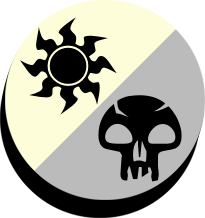Trivium: Design Goals
| Trivium: Cardlist | Visual spoiler | Export | Booster | Comments | Search | Recent activity |
| Mechanics | Design Goals | Worldbuilding | Skeleton | Draft Archetypes |
This set is intended to provide a unique and - primarily - flavorful attempt at capturing the essence of the Roman Republic. Because of this, some specific design choices were made:
White is the dominant color of the plane and of the set: The set focuses primarily on Rome and Roman life itself. Because of this, White - the color of law, order, and structured society - will have an weighted representation in the set. The set will highlight White's influence on each other color, and how each color tries to "resist" White influence. To get an idea of the color balance, an average draft pod will usually have 3-4 people in  (in a normal set). In this set, the number aims to have around 6 people in
(in a normal set). In this set, the number aims to have around 6 people in  . Subject to change.
. Subject to change.
The on-board complexity of this set is much higher than normal - This was a conscious decision to really capture the flavor of a white/Roman-dominated world. That isn't to say that NWO is eschewed completely, but many of the mechanics would be redflagged under NWO. Paying attention to the consequences of various actions and remembering triggers will be paramount for players in this set - just as the Romans had so many laws and traditions that had to be followed. Consequently, the combat step is going to be more important than normal - assigning the correct blocker and attacking at the right time is going to be more vital to succeeding in this format.
There is a reduced amount of reactive spells - That isn't to say that there won't be any combat tricks or other reactive spells, but since the on-board complexity is higher than normal, the off-board complexity will be lower than normal. In other words, you won't have to remember too many instants or sorceries if your opponent is holding up mana, and most instants will cost 3 or more. For comparison, Shadows over Innistrad had 20 instant-speed cards at common, with 11 of them being 2 or less CMC. Trivium is currently aiming for 12-13 instant-speed cards at common, with only at 2 or less CMC. I wanted to evoke a feeling of two generals playing Chess with each other. Not really a Roman-exclusive concept, but I feel its an important one to capture all of the warfare in Roman times. In other words, a good old-fashioned battle of wits, where your opponent is familiar with your tactics and army as much as you are of theirs.
Subtheme: The Number 3 - Taking inspiration from the Triumvirates, the number 3 is ingrained into the lore and mechanics of the set. You'll see it pop-up in a couple of one-off designs, as well as being the sweet spot for certain mechanics (Battalion especially).
Analogues:
 : Roman Beaurocracy and Government
: Roman Beaurocracy and Government
 : Patricians, Plebians, and Class Intrigue
: Patricians, Plebians, and Class Intrigue
 : The Roman Legions
: The Roman Legions
 : Pagan Traditions and Religious Institutions
: Pagan Traditions and Religious Institutions
Anti-
 : Greeks; The Macedonian Wars
: Greeks; The Macedonian Wars
Anti-
 : Carthaginians; The Punic Wars
: Carthaginians; The Punic Wars
Anti-
 : Gaul; The Gallic Wars
: Gaul; The Gallic Wars
Anti-
 : Samnites & Britons; The Samnite Wars / Roman Occupation of Briton
: Samnites & Britons; The Samnite Wars / Roman Occupation of Briton
Mechanics:
Against the Law // Breaking a Law  :
Mechanic of the Roman Senate. Basically, on each card with the mechanic, a certain action will be prohibited by law. The card will also have a second ability that lists a reward that happens whenever an opponent breaks any law - not necessarily the one spelled out on the card. Generally these rewards are relatively minor - gaining some life, drawing a card, etc. These have the option to compound - for example, if your currently enacted laws are "Can't cast instant or sorcery spells." and "Can't cast multicolored spells.", and an opponent casts a multicolored instant, the law is broken twice, so you get to punish the offending player by reaping double the rewards on both of the cards. Cards with this mechanic are usually defensive in nature. There will be no cards that have only a law or only a reward for an opponent breaking the law - all cards will be "playable" by themselves (though usually it will amount to trinket text until you reach a critical mass of laws). In
:
Mechanic of the Roman Senate. Basically, on each card with the mechanic, a certain action will be prohibited by law. The card will also have a second ability that lists a reward that happens whenever an opponent breaks any law - not necessarily the one spelled out on the card. Generally these rewards are relatively minor - gaining some life, drawing a card, etc. These have the option to compound - for example, if your currently enacted laws are "Can't cast instant or sorcery spells." and "Can't cast multicolored spells.", and an opponent casts a multicolored instant, the law is broken twice, so you get to punish the offending player by reaping double the rewards on both of the cards. Cards with this mechanic are usually defensive in nature. There will be no cards that have only a law or only a reward for an opponent breaking the law - all cards will be "playable" by themselves (though usually it will amount to trinket text until you reach a critical mass of laws). In  and
and  , there may be cards that allow a player to benefit whenever they break the law. Certain artifacts will also have laws written on them.
, there may be cards that allow a player to benefit whenever they break the law. Certain artifacts will also have laws written on them.
Oath // Sworn to Color  :
Mechanic of Roman Tradition and Religion. Whenever you cast a spell with Oath, you pick a color. Then, the spell usually has additional text that keys off of the color you are sworn to. Note that when you pick a color, any color you originally swore an oath to is lost; you can only declare your allegiance to one color at a time. The goal is to encourage monocolor decks so that you gain the most benefit from swearing an oath to a single color. This color will have higher than normal representation in
:
Mechanic of Roman Tradition and Religion. Whenever you cast a spell with Oath, you pick a color. Then, the spell usually has additional text that keys off of the color you are sworn to. Note that when you pick a color, any color you originally swore an oath to is lost; you can only declare your allegiance to one color at a time. The goal is to encourage monocolor decks so that you gain the most benefit from swearing an oath to a single color. This color will have higher than normal representation in  and
and  in order to encourage sticking to one color or the other. Certain spells not in those colors will also have Oath - but they won't necessarily be beneficial effects for permanents of that color. For example, a Red creature with Oath might have the text "Creatures of the color you are sworn to can't block ~." This effect appears on both permanents and nonpermanents.
in order to encourage sticking to one color or the other. Certain spells not in those colors will also have Oath - but they won't necessarily be beneficial effects for permanents of that color. For example, a Red creature with Oath might have the text "Creatures of the color you are sworn to can't block ~." This effect appears on both permanents and nonpermanents.
Battalion  :
Mechanic of the Roman Legions. This Gatecrash "favorite" returns largely unchanged for the most part. The key difference is that all effects generated by Battalion abilities will affect the whole team of attacking creatures, rather than the individual attacking creature. For this reason, the mechanic should encourage players to build up their armies before launching an attack, because the individual creature with Battalion is otherwise weak. Many of the support spells for the archetype will generate a single 1/1 Soldier in order to support this archetype.
:
Mechanic of the Roman Legions. This Gatecrash "favorite" returns largely unchanged for the most part. The key difference is that all effects generated by Battalion abilities will affect the whole team of attacking creatures, rather than the individual attacking creature. For this reason, the mechanic should encourage players to build up their armies before launching an attack, because the individual creature with Battalion is otherwise weak. Many of the support spells for the archetype will generate a single 1/1 Soldier in order to support this archetype.
Shame  :
Mechanic of the Roman Classes. Partly meant to show the class struggles between patrician and plebian that Rome suffered in its early days, as well as capture how important oratory skills were in Roman life. Basically, it turns a creature into a 1/1 with no abilities until your next turn - ridding you temporarily of a pesky static ability that might be preventing you from doing something, or turning an unfavorable attack into a favorable one. The creature is still able to attack and block, so its not completely mitigated - but removing of abilities is huge in a format with a lot of static abilities that make boardstates a pain to keep track of. Because of how many 1/1 tokens there will be because of White's ubiquitousness and need for battalion, there will be a few cards that will give benefits to 1/1 creatures as well.
:
Mechanic of the Roman Classes. Partly meant to show the class struggles between patrician and plebian that Rome suffered in its early days, as well as capture how important oratory skills were in Roman life. Basically, it turns a creature into a 1/1 with no abilities until your next turn - ridding you temporarily of a pesky static ability that might be preventing you from doing something, or turning an unfavorable attack into a favorable one. The creature is still able to attack and block, so its not completely mitigated - but removing of abilities is huge in a format with a lot of static abilities that make boardstates a pain to keep track of. Because of how many 1/1 tokens there will be because of White's ubiquitousness and need for battalion, there will be a few cards that will give benefits to 1/1 creatures as well.  will also be a defensive color, with plenty of 1/Xs to go around. Black, being the color of underhanded tricks, will also recieve the bulk of the reduced amount of instants, leading the archetype to be a more opportunistic type of defensive strategy.
will also be a defensive color, with plenty of 1/Xs to go around. Black, being the color of underhanded tricks, will also recieve the bulk of the reduced amount of instants, leading the archetype to be a more opportunistic type of defensive strategy.
More to come later...
